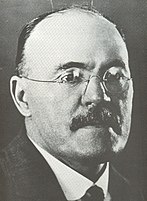New South Wales state election, 1927
|
|
||||||||||||||||||||||||||||||||||
|---|---|---|---|---|---|---|---|---|---|---|---|---|---|---|---|---|---|---|---|---|---|---|---|---|---|---|---|---|---|---|---|---|---|---|
|
||||||||||||||||||||||||||||||||||
|
All 90 seats in the New South Wales Legislative Assembly 46 Assembly seats were needed for a majority |
||||||||||||||||||||||||||||||||||
|
||||||||||||||||||||||||||||||||||

Legislative Assembly after the election
|
||||||||||||||||||||||||||||||||||
|
||||||||||||||||||||||||||||||||||
Thomas Bavin
Nationalist/Country coalition
The 1927 New South Wales state election to elect the 90 members of the 28th Legislative Assembly was held on 8 October 1927. During the previous parliament the voting system, which had been a form of proportional representation with multi-member seats and a single transferable vote (modified Hare-Clark), was changed to single member constituencies with optional preferential voting. Severe divisions occurred within the Australian Labor Party caucus in the four months prior to the election (see Lang Labor) and a caretaker government composed of the supporters of the Premier of New South Wales and party leader, Jack Lang was in power at the time of the election.
As a result of the election the Lang government was defeated and a Nationalist/Country Party coalition government led by Thomas Bavin and Ernest Buttenshaw was formed with a parliamentary majority of 1 and the usual support of the 2 Nationalist independents. The Parliament first met on 3 November 1927, and ran its maximum term of 3 years. Lang remained the leader of the Labor Party throughout the Parliament.
New South Wales state election, 29 October 1927
Legislative Assembly
<< 1925 — 1930 >>
...
Wikipedia


